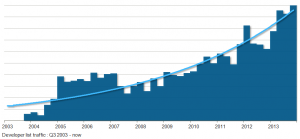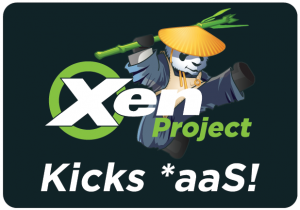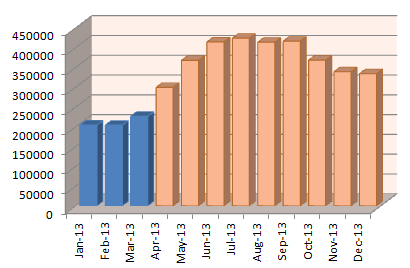2013 has been a year of changes for the Xen Community. I wanted to share my five personal highlights of the year. But before I do this, I wanted to thank everyone who contributed to the Xen Project in 2013 and the years before. Open Source is about bringing together technology and people : without your contributions, the Xen Project would not be a thriving and growing open source project.
Xen Project joins Linux Foundation
The biggest community story of 2013, was the move of Xen to the Linux Foundation in April. For me, this journey started in December 2011, when I won in-principle agreement from Citrix to find a neutral, non-profit home for Xen. This took longer than I hoped: even when the decision was made to become a Linux Foundation Collaborative project, it took many months of hard work to get everything off the ground. Was it worth it? The answer is a definite yes: besides all the buzz and media interest in April 2013, interest in and usage of Xen has increased in the remainder of 2013. The Xen Project became a first class citizen within the open source community, which it was not really before.
Developer Community Growth

Besides growth in website visits, we have also seen a marked increase in developer list conversations in 2013.
Shorter Release Cycles
Another notable change that started in late 2012, was a reduction of the Release Cadence for the Xen Hypervisor and a better approach to release planning. I wanted to thank George Dunlap – our Xen Release coordinator – for driving these changes. Let’s look at release times since Xen 4.0: it took 11 months to develop Xen 4.1, 18 months to develop Xen 4.2, 10 months to develop Xen 4.3 and 6 or 7 months for Xen 4.4 (planned to release in February 2014). The goal is to release Xen twice a year, while increasing the number of features that are going into each Xen release. If you look at the list of planned Xen 4.4 features, we are well on track to achieving this goal.
Innovation, Innovation, Innovation
In 2013 the Xen Project started to innovate in many different technology areas. This is reflected in the many presentations that were given at the Xen Project Developer Summit. Besides the usual improvements to performance and scalability, I wanted to pick out some personal highlights.
 Xen 4.3 saw some real advances in cloud security: very timely, given that cloud and internet security was a very hot topic in 2013. Next year, we will look at making many of these features easier to use and integrate them better into Linux distros.
Xen 4.3 saw some real advances in cloud security: very timely, given that cloud and internet security was a very hot topic in 2013. Next year, we will look at making many of these features easier to use and integrate them better into Linux distros.- Another notable change is PVH guest support (coming to Xen 4.4 for Linux and FreeBSD). PVH combines the best elements of HVM and PV into a mode which allows Xen to take advantage of many of the hardware virtualization features without needing to emulate an entire physical server. This will allow for increased efficiency, as well as reduced footprint in Linux, FreeBSD and other operating systems. A special thank you to Mukesh Rathor from Oracle, who developed this groundbreaking technology.
- Of course, we also have to mentioned Xen on ARM support that first appeared in Xen 4.3 and will be hardened for Xen 4.4. This support is helping to expand Xen Hypervisor usage into new market segments. In October 2013, we saw first prototypes of Android running on top of Xen at remarkable speed. But more on this later. A special thank you to Stefano Stabellini and Ian Campbell for driving this effort.
- Support for VMWare guests: just before XMas Verizon posted a patch series for review, that will allow users to run Linux, Windows and other guest images that were built for VMware products, unchanged within Xen. These features will not make it into Xen 4.4, but should be available later in 2014.
- Intel and Samsung showed groundbreaking work in GPU virtualization at the last Xen Project Developer Summit, which have the potential to extend Xen into new market sefgments.
Of course, not all of these innovations will make it into Xen 4.4: some will appear in Xen 4.5 or later.
New Frontiers of Virtualization
One of the things which surprised me personally, is that we are seeing the Xen Hypervisor adopted in many new (and unexpected) market segments. Examples are: Automotive and In-Vehicle Infotainment, Mobile Use-cases, Network Function Virtualization, Set-Top Boxes and other Embedded Applications. This will without doubt, be a theme of 2014. It may seem counter intuitive, but I believe that expanding the use of Xen to new frontiers, will create benefits and opportunities in server virtualization and cloud computing. It also proves, that Xen is an extremely flexible platform that can be customized for many different applications.
In any case, thank you all for making 2013 an exceptional year!
And a Happy New Year to all of you!

